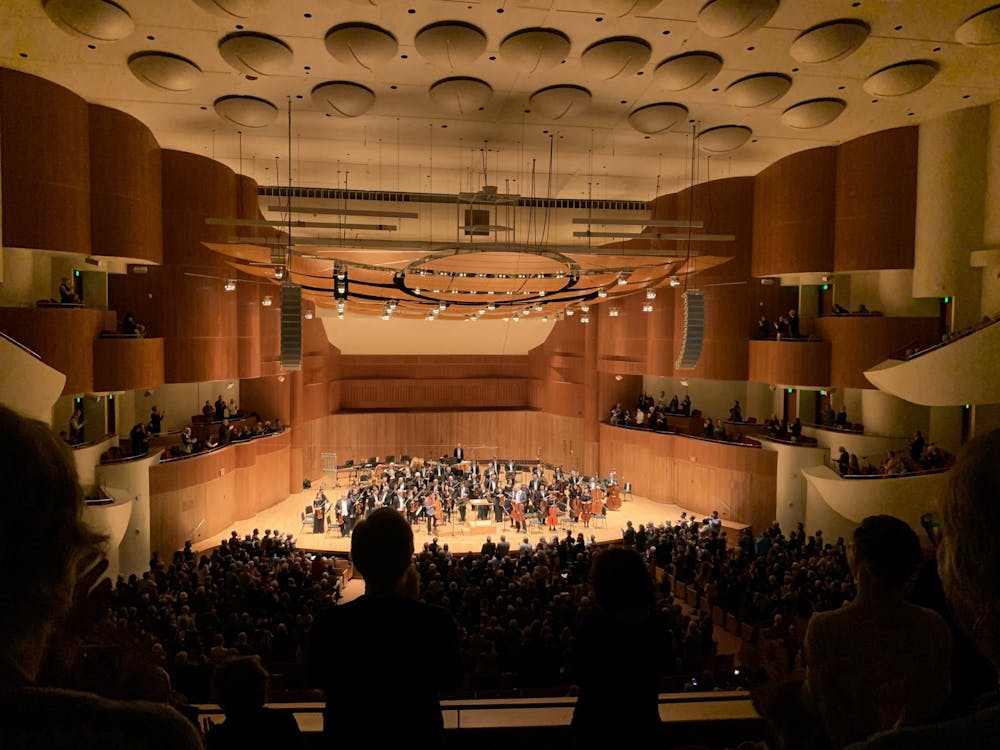After Spotify’s end-of-the-year wrap-up informed me that I had the tendency of listening to the same songs on repeat, I decided what my grand — for an introvert, at least — 2020 New Year’s resolution would be: to listen to a greater variety of music in settings where I could not be simply wired to a device.
I’m a former pianist and cellist, so the concert hall wasn’t necessarily a new, unfamiliar venue. But after memories from my last concert hall experiences in high school began to reach their expiry, I decided to attend my first Baltimore Symphony Orchestra (BSO) performance at Meyerhoff Symphony Hall, which happened to feature one of my favorite cellists of my generation, Sheku Kanneh-Mason, on the weekend of Friday, Jan. 31.
I was first introduced to Sheku Kanneh-Mason after the iconic 2018 royal wedding where Meghan Markle, now the Duchess of Sussex, personally invited the rising British cellist to perform. Kanneh-Mason played Maria Theresia von Paradis’ Sicilienne in E Flat Major, Gabriel Fauré's “Après Un Rêve” and Franz Schubert's “Ave Maria,” and the moments of his captivating performance carried over into the following weeks of ceremonial buzz.
The 20-year-old Kanneh-Mason, who attends London’s Royal Academy of Music, has achieved so much that I am almost ashamed to acknowledge that we are the same age.
He won the BBC’s 2016 Young Musician of the Year contest; he has performed twice at the British Academy Film and Television Arts Awards; and he was announced as a recipient of the Most Excellent Order of the British Empire, a century-old accolade, at the end of last year.
On Friday evening, the Meyerhoff Symphony Hall, located near Mount Vernon, hosted a packed crowd of over 2,000 or something seats. Led by conductor Marin Alsop, the BSO opened the program with a piece titled The Oak, by Florence Price.
As an African American woman, Price was subject to racism throughout her musical career. Born in Little Rock, Ark. but eventually settling in Chicago, she became the first African American female composer whose work was selected by the Chicago Symphony Orchestra. However, her extensive collection of classical, folk and religious compositions were rediscovered only very recently.
The Oak begins with a guarded, gradual, layered crescendo, as if to express the fragile rise of dawn on a foggy morning.
As described in the program, “the brooding, mysterious opening of The Oak evokes the lush chromaticism of Wagner and Strauss. However, as the tempos accelerate, more American sounds emerge.”
The emotive denouement of the piece played out in the grandeur of beautiful chords, as the orchestra moved collectively in waves of conversation between the string and wind instruments.
The Oak was then followed by Sheku Kanneh-Mason’s solo performance of Camille Saint-Saëns’ Cello Concerto No. 1 in A minor, a very well-known piece from the Romantic period. As Kanneh-Mason sat down before the crowd, he became one with his cello, a privately loaned Antonius and Hieronymus Amati (c. 1610) with a silky, angelic tone. The first movement opened with its famous, robust sequence in A minor, after which the piece became a dynamic story interwoven with moments of anguish and moments of dream-like interludes, especially in my favorite third movement, the “Tempo primo.”
During the intermission, I could hear the gentleman beside me compare the cello’s voice to a human’s voice. Indeed, the piece felt like a very vocal expression that was layered with powerful overtones.
A long-lasting standing ovation finally led Kanneh-Mason to give a unique encore, where he simultaneously whistled and bowed the strings, at times even plucking with his left hand as he let the rest of the fingers on the neck of the cello designate themselves to complex chords. He then playfully stood up while continuing to whistle, walking off stage, as the audience began to roar with jubilee.
The night finally ended with Antonín Dvořák’s complete Symphony No. 7 in D minor, Op. 70. I had never heard this particular symphony, but I thoroughly enjoyed the Scherzo: Vivace and Finale: Allegro, the parts with faster, energetic tempos and loud percussion.
The night ended with a large buildup of accented octaves that produced a wonderful culmination. As I returned home, the sound of the strings still resounded powerfully in my heart, providing a bit of peaceful solace in the face of school’s stressful cacophony.
Overall the BSO delivered a wonderful program that I project will become one of the highlights of this new semester.
Musical viewership is somewhat of a paradox, but being able to both watch and listen with others is definitely an immersive experience I hope to take more advantage of.





